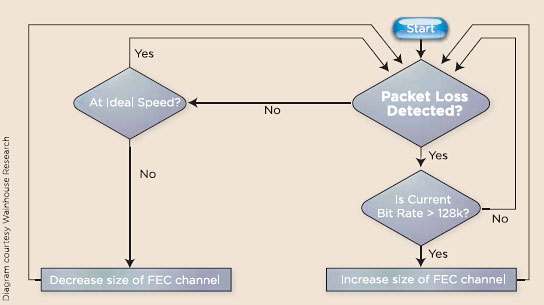Minimizing Packet Loss

The concept of a video phone call dates back to the overly- cited AT&T "Picturephone" demonstration at the 1964 World's Fair in New York. Yet videoconferencing, as we now call it, still has yet to become a mainstream communication tool. Why? There are many reasons, but at the heart of them all is that despite all the hype, the experience is just not as good as face-to-face.
One technical problem with videoconferencing is "packet loss," which happens when one or more transmitted packets of data fail to arrive at the appropriate destination. Packets can be lost because of network outages, network re-routing, congested routers, or other device failures.
Packet loss can range from 0 percent to 20 percent or more depending on the type of network, number of hops, and amount of congestion. The result of packet loss on a video call is poor quality audio and video, including the familiar video "tiling," distortion, audio drop outs, lip-synch mismatches, and a host of other issues. To say the least, it can dramatically impede video communication. Packet loss is less of a problem with data transfer that doesn't involve real-time AV signals, since the data can be re-transmitted without any noticeable disturbance. But with voice and videoconferencing over an IP network, it can be disastrous.
Many researchers and equipment manufacturers have been working on band-aid solutions to prevent packet loss. One common approach uses a buffer (called a jitter buffer) on the receive side of the video connection for IP data packets that are delayed a short time or arrive out of sequence. However, since buffers add latency (delay), this is not a preferable method for real-time videoconferencing or streaming. A preventative solution that occurs at the send side of a connection is Forward Error Correction (FEC). FEC involves adding redundancy to the information, so if part of the information doesn't arrive, the data can be recreated using the redundant data - and without having to re-transmit.
Unified communications equipment manufacturer Polycom has developed a new approach that uses FEC to compensate for packet loss during videoconferencing, and so far the reviews have been favorable. In fact, Wainhouse Research, the Duxbury, MA-based market research and analysis firm, has completed a thorough evaluation of Polycom's "Lost Packet Recovery" technology, which is an algorithm available on Polycom's HDX and most VSX video systems. Wainhouse Research analyzed the methods used by currently available videoconferencing systems to conceal the effect of network errors, then set up a number of video systems in a test lab, placed a series of test calls that included varying levels of packet loss, and observed the results. Among their conclusions was that "LPR's ability to protect the video call experience from the effects of packet loss - especially random/bursty packet loss - is exceptional." Their tests confirmed that LPR works best for masking the impact of limited packet loss of up to 5 percent.
According to the Wainhouse report, Polycom's LPR offers five key benefits:
- 1. Packet loss protection
- 2.Compensation for temporary network issues
- 3. Decreased latency/delay (under certain conditions)
- 4. Resource efficiency -5. Total media protection
To achieve these results, Polycom video endpoints monitor all active calls for incoming packet loss. Once packet loss is detected, LPR goes into action. Unlike most error concealment/avoidance algorithms, LPR involves both the sending and receiving video systems in the call.
A daily selection of features, industry news, and analysis for tech managers. Sign up below.
LPR works by temporarily allocating a portion of the call bandwidth into a data channel used for sending FEC data to the receive system. Through an iterative process, LPR increases and decreases the size of the FEC data channel until it finds the minimum bandwidth that must be allocated to the FEC data channel to allow the receive system to recover all lost packets.
When FEC is in use, the systems repeatedly test whether they can decrease the size of the FEC data channel and thereby make a greater portion of the call bandwidth available for the audio, video, and content data. Hence, LPR uses bandwidth only when packet loss is detected. According to Wainhouse, this makes LPR ideally suited for environments with random or bursts of packet loss (like the internet). While they did report a few "downsides" such as increased bandwidth and processing requirements and, potentially, some additional latency, the Wainhouse assessment was overall positive, stating that "...the compromises associated with LPR - even in the extreme - represent a very favorable trade."
The AVNetwork staff are storytellers focused on the professional audiovisual and technology industry. Their mission is to keep readers up-to-date on the latest AV/IT industry and product news, emerging trends, and inspiring installations.
